Podocytes require the engagement of cell surface heparan sulfate proteoglycans for adhesion to extracellular matrices
- PMID: 20463653
- PMCID: PMC3125125
- DOI: 10.1038/ki.2010.136
Podocytes require the engagement of cell surface heparan sulfate proteoglycans for adhesion to extracellular matrices
Abstract
Podocytes adhere to the glomerular basement membrane by cell surface receptors. Since in other cells these adhesions are enhanced by cell surface proteoglycans, we examined the contribution of these molecules and their glycosaminoglycan side chains to podocyte adhesion by developing immortalized podocyte cell lines with (control) or without (mutant) heparan sulfate glycosaminoglycan chains. In adhesion assays control podocytes attached, spread, and migrated more efficiently compared with mutants, indicating a requirement for heparan sulfate chains in these processes. The proteoglycan syndecan-4 is known to have direct effects on cell attachment, spreading, and cytoskeletal organization. We found it localized to focal adhesions in control podocytes coincident with stress fiber formation. In mutant cells, syndecan-4 was associated with smaller focal contacts and cortical actin organization. Analysis by flow cytometry showed that mutant cells had twice the amount of surface syndecan-4 of control cells. Protein kinase Cα, a signaling molecule bound to and activated by syndecan-4, showed a fourfold increase in membrane localization-activation than that seen in control cells. In vivo, the loss of heparan sulfate glycosaminoglycans in PEXTKO mice led to a loss of glomerular syndecan-4. Overall, our study provides further evidence for a dynamic role of cell surface heparan sulfate glycosaminoglycans in podocyte activity.
Figures
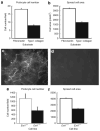

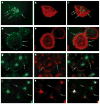
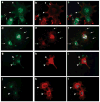

 , HS + cells stained for syndecan-4
, HS + cells stained for syndecan-4
 , and HS− cells stained for syndecan-4
, and HS− cells stained for syndecan-4
 . The chart shows the relative fluorescence intensity values for syndecan-4 staining in HS+ and HS− cells. The data show a net increase in the staining for syndecan-4 in HS− cells.
. The chart shows the relative fluorescence intensity values for syndecan-4 staining in HS+ and HS− cells. The data show a net increase in the staining for syndecan-4 in HS− cells.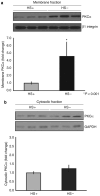

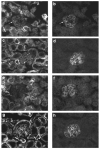
Similar articles
-
N-sulfation of heparan sulfate is critical for syndecan-4-mediated podocyte cell-matrix interactions.Am J Physiol Renal Physiol. 2016 May 15;310(10):F1123-35. doi: 10.1152/ajprenal.00603.2015. Epub 2016 Mar 2. Am J Physiol Renal Physiol. 2016. PMID: 26936875 Free PMC article.
-
Cell surface heparan sulfate proteoglycans control adhesion and invasion of breast carcinoma cells.Mol Cancer. 2015 Jan 27;14(1):15. doi: 10.1186/s12943-014-0279-8. Mol Cancer. 2015. PMID: 25623282 Free PMC article.
-
Loss of heparan sulfate glycosaminoglycan assembly in podocytes does not lead to proteinuria.Kidney Int. 2008 Aug;74(3):289-99. doi: 10.1038/ki.2008.159. Epub 2008 May 14. Kidney Int. 2008. PMID: 18480751 Free PMC article.
-
Syndecan proteoglycan contributions to cytoskeletal organization and contractility.Scand J Med Sci Sports. 2009 Aug;19(4):479-89. doi: 10.1111/j.1600-0838.2009.00941.x. Epub 2009 Jun 15. Scand J Med Sci Sports. 2009. PMID: 19538537 Review.
-
Syndecan-4 and integrins: combinatorial signaling in cell adhesion.J Cell Sci. 1999 Oct;112 ( Pt 20):3415-20. doi: 10.1242/jcs.112.20.3415. J Cell Sci. 1999. PMID: 10504290 Review.
Cited by
-
The Life of a Kidney Podocyte.Acta Physiol (Oxf). 2025 Aug;241(8):e70081. doi: 10.1111/apha.70081. Acta Physiol (Oxf). 2025. PMID: 40698593 Free PMC article. Review.
-
Cell-matrix adhesion of podocytes in physiology and disease.Nat Rev Nephrol. 2013 Apr;9(4):200-10. doi: 10.1038/nrneph.2012.291. Epub 2013 Jan 22. Nat Rev Nephrol. 2013. PMID: 23338211 Review.
-
Podocyte-actin dynamics in health and disease.Nat Rev Nephrol. 2016 Nov;12(11):692-710. doi: 10.1038/nrneph.2016.127. Epub 2016 Aug 30. Nat Rev Nephrol. 2016. PMID: 27573725 Review.
-
Glomerular basement membrane heparan sulfate in health and disease: A regulator of local complement activation.Matrix Biol. 2017 Jan;57-58:299-310. doi: 10.1016/j.matbio.2016.09.002. Epub 2016 Sep 6. Matrix Biol. 2017. PMID: 27609404 Free PMC article. Review.
-
N-sulfation of heparan sulfate is critical for syndecan-4-mediated podocyte cell-matrix interactions.Am J Physiol Renal Physiol. 2016 May 15;310(10):F1123-35. doi: 10.1152/ajprenal.00603.2015. Epub 2016 Mar 2. Am J Physiol Renal Physiol. 2016. PMID: 26936875 Free PMC article.
References
Publication types
MeSH terms
Substances
Grants and funding
LinkOut - more resources
Full Text Sources
Other Literature Sources
Molecular Biology Databases

